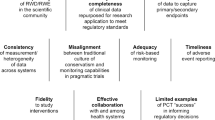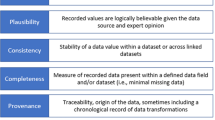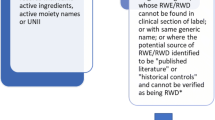Abstract
Randomized controlled clinical trials are the gold standard for evaluating the safety and efficacy of pharmaceutical drugs, but in many cases their costs, duration, limited generalizability, and ethical or technical feasibility have caused some to look for real-world studies as alternatives. On the other hand, real-world data may be much less convincing due to the lack of randomization and the presence of confounding bias. In this article, we propose a statistical roadmap to translate real-world data (RWD) to robust real-world evidence (RWE). The Food and Drug Administration (FDA) is working on guidelines, with a target to release a draft by 2021, to harmonize RWD applications and monitor the safety and effectiveness of pharmaceutical drugs using RWE. The proposed roadmap aligns with the newly released framework for FDA’s RWE Program in December 2018 and we hope this statistical roadmap is useful for statisticians who are eager to embark on their journeys in the real-world research.



Similar content being viewed by others
References
Franklin JM, Schneeweiss S. When and how can real world data analyses substitute for randomized controlled trials? Clin Pharmacol Ther. 2017;102(6):924–33.
Hernan MA, Robins JM. Causal inference: What If. Boca Raton: Chapman & Hall/CRC; 2020.
Sherman RE, Anderson SA, Pan GJD, et al. Real-world evidence—what is it and what can it tell us? N Engl J Med. 2016;375(23):2293–7.
Farrugia P, Petrisor BA, Farrokhyar F, Bhandari M. Research questions, hypotheses and objectives. Can J Surg. 2010;53(4):278–81.
Haynes RB. Forming research questions. J Clin Epidemiol. 2006;59(9):881–6.
Petersen ML, van der Laan MJ. Causal models and learning from data. Epidemiol Camb Mass. 2014;25(3):418–26.
Imbens GW, Rubin DB. Causal inference in statistics, social, and biomedical sciences. Cambridge: Cambridge University Press; 2015.
van der Laan MJ, Rose S. Targeted learning: causal inference for observational and experimental data. New York: Springer; 2011. http://public.eblib.com/choice/publicfullrecord.aspx?p=763456. Accessed May 17, 2019.
van der Laan MJ, Rose S. Targeted learning in data science: causal inference for complex longitudinal studies. New York: Springer; 2018.
Rosenbaum PR, Rubin DB. The central role of the propensity score in observational studies for causal effects. Biometrika. 1983;70(1):41–55.
van der Laan MJ, Polley EC, Hubbard AE. Super learner. Stat Appl Genet Mol Biol. 2007. https://doi.org/10.2202/1544-6115.1309.
Cornfield J, Haenszel W, Hammond EC, Lilienfeld AM, Shimkin MB, Wynder EL. Smoking and lung cancer: recent evidence and a discussion of some questions. J Natl Cancer Inst. 1959;22(1):173–203.
Greenland S. Multiple-bias modelling for analysis of observational data. J R Stat Soc Ser A. 2005;168(2):267–306.
VanderWeele T, Ding P. Sensitivity analysis in observational research: introducing the E-value. Ann Intern Med. 2017;167(4):268–74.
Hammond EC, Horn D. Smoking and death rates—report on 44 months of follow-up of 187,783 men: 2. Death rates by cause. Am Med Assoc. 1958;166(11):1294–308.
Fisher RA. Cancer and smoking. Nature. 1958;182:596.
Brookhart MA, Schneeweiss S, Rothman KJ, Glynn RJ, Avorn J, Stürmer T. Variable selection for propensity score models. Am J Epidemiol. 2006;163(12):1149–56.
Disclaimers
The comments provided here are solely those of the presenters and are not necessarily reflective of the positions, policies or practices of authors’ employers.
Author information
Authors and Affiliations
Corresponding author
Ethics declarations
Conflict of interest
The authors declare that they have no conflict of interest.
Additional information
Publisher's Note
Springer Nature remains neutral with regard to jurisdictional claims in published maps and institutional affiliations.
Rights and permissions
About this article
Cite this article
Fang, Y., Wang, H. & He, W. A Statistical Roadmap for Journey from Real-World Data to Real-World Evidence. Ther Innov Regul Sci 54, 749–757 (2020). https://doi.org/10.1007/s43441-019-00008-2
Received:
Accepted:
Published:
Issue Date:
DOI: https://doi.org/10.1007/s43441-019-00008-2




